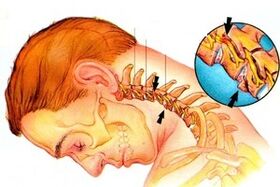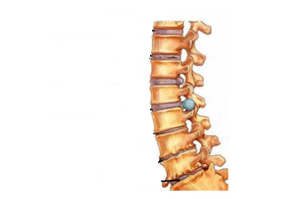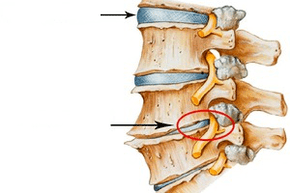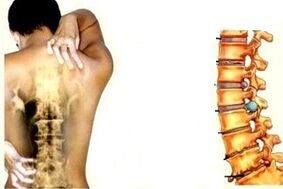
Diseases of the musculoskeletal system are one of the most common diseases on Earth.Few people manage to avoid them completely, especially after 40 years, although experts admit that problems with the spine, muscles and joints have "younger", and young people are increasingly complaining about pain.
The fault of this is the way of life, which has already become familiar to many: inactivity, prolonged stay in a position (more often behind devices and monitors), lack of physical activity.As a result, the posture is disturbed, salts and other harmful substances accumulate in the body, the functions of the musculoskeletal system are affected and, as a result, internal organs can deform.
Very often, there is the osteochondrosis of such diseases, which people are subject to a greater and quite young age, and among the problems of osteochondrosis with the lumbosacral and cervical column.The second type of more frequency, cervical osteochondrosis is an unpleasant and, in addition, progressive disease, without treatment, a lifestyle that worsens significantly to disability.This means that it is necessary to recognize the symptoms of this disease in a timely manner and, over time, communicate with an orthopedist or a vertebrologist for treatment.
How cervical osteochondrosis develops
If a person leads a sedentary lifestyle or, by virtue of his profession, he is in the same position for a long time, then the risk of fulfilling the osteochondrosis is very high.With the development of the disease, the changes occur in the intervertebral discs, their structure is deform and change.
The intervertebral discs are among the vertebrae, their task is to keep the spine, to make it flexible and durable.There are seven vertebrae in the neck, with the help of which the head is supported and turned, the neck and so on they bend.The cervical vertebrae are very close to each other, so they are injured and changed even of a minor physical effort.The danger of the disease lies in the fact that the nerve endings of the spinal nerves are affected, because the vessels that supply the brain of the brain are affected.In turn, the brain does not receive vital substances, and this can lead to the development of a series of other more serious diseases that can cause disability and even the patient's death.
There are many causes and development of cervical osteochondrosis.Among the most common and frequent reasons, the following can be distinguished:

- Deteriorated metabolism in the body, in particular, in the cervical region, the hormonal imbalance;
- salt deposition;
- Low physical activity, sedentary lifestyle;
- remain in a position for a long time (in front of the computer, driving a car, etc.);
- Bad nutrition;
- overweight;
- lesions and bruises on the neck;
- Body hypothermia.
Osteochondrosis also occurs in the context of chronic diseases of the musculoskeletal system, such as scoliosis or rheumatism.
In addition, a genetic predisposition of the body often leads to osteochondrosis.
But whatever reasons, osteochondrosis should be treated as soon as the first symptoms appear.
Signs of cervical osteochondrosis.
Osteochondrosis in this part of the column does not always happen suddenly and unexpectedly.Most of the time it develops slowly and the symptoms intensify over time and its number increases.The more the vertebrae are damaged and the nerve roots are pinned, the more noticeable the symptoms are.
The first symptom to which you should pay attention is the pain of variable intensity in the cervical column, which radiates to other parts of the body: the back of the head, the forehead, the ears, the forearm, the shoulders, the chest, etc.If you feel pain, you should consult a doctor to determine if it really is osteochondrosis, which often has symptoms similar to those of other diseases.
Other signs of osteochondrosis
- Neck pain increases with the effort or turning the head;
- The patient feels numbness, burned or tingling in the limbs;
- Headaches and dizziness, a collapse, the patient may complain about obscuring and flying in his eyes, noise in his ears;
- With a strong turn of the head, it is likely to be passed out.
Osteochondrosis is also characteristic of cervical osteochondrosis:
- violation of coordination;
- heart pain;
- Deterioration of vision and hearing.
Varieties of osteochondrosis
Depending on the type of nerve pinch and the nature of the development of the disease, doctors distinguish several syndromes:
- spinal syndrome;
- Vertebral artery syndrome;
- Cardial syndrome.
The root syndrome is a pinch of the first pairs of cervical nerve endings.The pains feel in the neck, they occur in a shoulder blade, lower back, shoulder, forearm.
With the vertebral artery syndrome, the patient experiences a pulsating pain on the back of the head or temples or burning pain in the neck, the back of the head, which improves the head, during sleep, with cough, gives the chest, shoulder.
With cardiac syndrome, the symptoms first resemble the angina of pectoris, but the pain does not happen after taking nitroglycerin, lasts several hours and can intensify when it moves and breathes deep.
Symptoms of damage to specific vertebrae
The treatment of osteochondrosis is prescribed depending on which the end of the nerve was damaged.There are only eight of them, each of them is above the cervical vertebra.It is possible to determine which of the vertebrae is affected by the symptoms corresponding to a certain nerve column.
Damage to the end nervous and characteristic pains

- The first and second departments: the sensitivity of the back of the head, the pain in the parietal and occipital region is broken;
- The third department: numbness of the neck in the field of pinch, speech disability, language sensitivity;It happens very rare;
- The fourth department: pain and numbness in the clavicle and/or shoulder, violations of the respiratory system, heart pain;
- Fifth section: shoulder pain, pain on the outer surface of the shoulder, altered limb sensitivity;
- The sixth and seventh departments: neck pain, blade, forearm, back, lower back, deteriorated sensitivity of hands, fingers;The most frequent defeat;
- The eighth department: neck pain, back, elbow, numbness of small fingers of all limbs, blue legs and brushes due to blood circulation disorders, lack of skin sensitivity, and gives it to the legs.
Diagnosis and treatment of cervical osteochondrosis

To reliably establish the diagnosis of "cervical osteochondrosis", you should definitely consult a doctor.Many symptoms of osteochondrosis are similar to the signs of other diseases, so it is important not only in time to begin the treatment of osteochondrosis, but other pathology is not lost.
In case of suspicion of osteochondrosis and pinch signs of nerve endings, the doctor prescribes radiography, with magnetic resonance tomography or data failure, ultrasonic additional dopplerography and duplex scanning.
According to these studies, the nature of pain syndrome and all other symptoms, can determine which discs are damaged and begin the necessary treatment, which will restore vertebrae and nervous roots affected and will not allow complications of osteochondrosis to develop.
The doctor is prescribed by the treatment, it is usually complex.First, it must relieve the symptoms of pain, which, with cervical osteochondrosis, are sometimes virtually unbearable and spread not only to the neck, but also to other parts of the body.
To do this, use analgesics in tablets, but in the case of too severe pain, non -steroidal anti -inflammatory medications, as well as heating and analgesics.
Since medications and ointments only relieve pain and other symptoms of neck osteochondrosis, but do not eliminate their cause.Once the pain decreases, the patient is prescribed massages, physiotherapy and physiotherapy.The patient is prescribed a diet, medications that improve blood circulation and support bodily functions, tablets and injections, as well as condoprotectors that help protect and restore the tissue of the intervertebral disc.
In some cases, as an additional treatment, the patient is prescribed bathrooms, paraffin, reflexology and hirudotherapy baths.Traditional methods to treat cervical osteochondrosis often also help the patient return to a normal lifestyle, but should be used only in combination with traditional methods and after consulting with a doctor, since traditional medicine can have contraindications and the use of their recipes can damage an organism already weakened by the disease.
Complications and disease prevention.

Do not forget it: the treatment of cervical osteochondrosis must begin as soon as possible.The more I expect to see a doctor, the more difficult it will be to cure the disease and, meanwhile, can cause various complications.The osteochondrosis of the cervical column is very dangerous because this section contains many blood vessels and nerve plexus that irrigate the brain.
Any alteration can cause problems with brain circulation, neurological disorders, including migraines and hypertension, and affect the heart, respiratory system, audition and vision.
If the osteochondrosis begins, they are possible more serious consequences in the form of cerebral ischemia, spinal stroke or radicleopathy, a disease in which processes are formed in the affected vertebrae, which totally or partially deprive the body of sensitivity and mobility.But this is not the worst, since in severe cases of osteochondrosis the spinal cord is compressed, which can cause the death of the patient.
Therefore, it is very important to listen to the symptoms as soon as possible and contact a specialist who will help you return to a full life.And to avoid a disease such as cervical osteochondrosis, it is necessary to move more, not avoid physical activity, control weight, eat a healthy and balanced diet and periodically visit an orthopedist or vertebrologist.

























